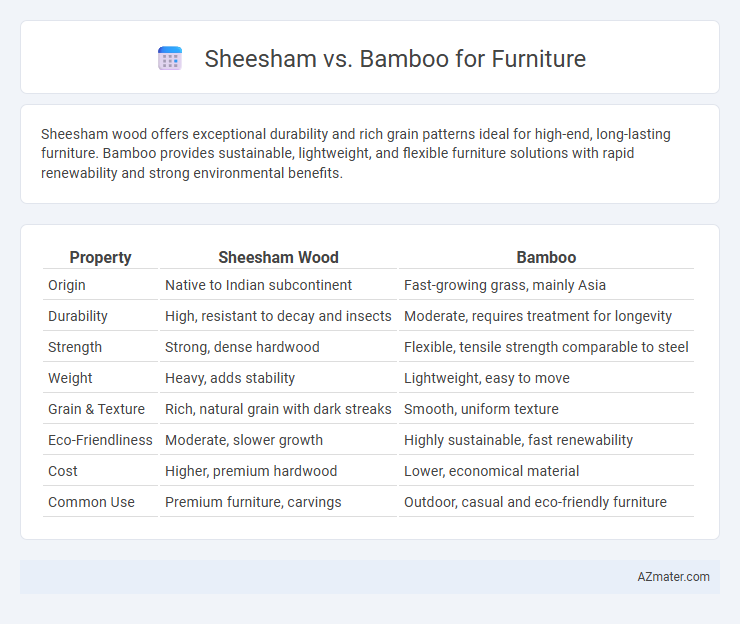Sheesham wood offers exceptional durability and rich grain patterns ideal for high-end, long-lasting furniture. Bamboo provides sustainable, lightweight, and flexible furniture solutions with rapid renewability and strong environmental benefits.
Table of Comparison
| Property | Sheesham Wood | Bamboo |
|---|---|---|
| Origin | Native to Indian subcontinent | Fast-growing grass, mainly Asia |
| Durability | High, resistant to decay and insects | Moderate, requires treatment for longevity |
| Strength | Strong, dense hardwood | Flexible, tensile strength comparable to steel |
| Weight | Heavy, adds stability | Lightweight, easy to move |
| Grain & Texture | Rich, natural grain with dark streaks | Smooth, uniform texture |
| Eco-Friendliness | Moderate, slower growth | Highly sustainable, fast renewability |
| Cost | Higher, premium hardwood | Lower, economical material |
| Common Use | Premium furniture, carvings | Outdoor, casual and eco-friendly furniture |
Introduction to Sheesham and Bamboo Furniture
Sheesham furniture, crafted from Indian Rosewood (Dalbergia sissoo), is renowned for its durability, rich grain patterns, and natural resistance to pests and decay, making it a premium choice for long-lasting wooden pieces. Bamboo furniture, sourced from fast-growing bamboo species, offers flexibility, sustainability, and lightweight strength, often featuring a modern aesthetic ideal for eco-conscious consumers. Both materials provide unique benefits: Sheesham's robust hardwood qualities contrast with bamboo's renewable and versatile nature, influencing their distinct roles in furniture design.
Origins and Growth Patterns of Sheesham vs Bamboo
Sheesham, native to the Indian subcontinent, thrives in tropical and subtropical climates, developing dense, hard wood over decades, making it ideal for durable, long-lasting furniture. Bamboo, a fast-growing grass primarily found in Asia, can reach maturity within 3 to 5 years and regenerates quickly, providing sustainable, lightweight material for furniture production. The contrasting growth rates and origins of Sheesham and Bamboo influence their environmental impact, cost, and suitability for different furniture styles.
Durability and Strength Comparison
Sheesham wood, known for its dense grain and high oil content, offers superior durability and strength compared to bamboo, making it ideal for heavy-use furniture. Bamboo, while eco-friendly and fast-growing, is less dense and more prone to dents and scratches, reducing its longevity under constant stress. For long-lasting furniture that withstands daily wear, Sheesham ranks higher in durability and structural integrity than bamboo.
Aesthetic Appeal: Grain, Color, and Texture
Sheesham wood features a rich, dark grain with natural golden brown hues that enhance furniture with a luxurious and warm aesthetic appeal. Bamboo offers a lighter color palette, often creamy or pale yellow, with a subtle linear grain and smooth texture that lends a modern and minimalist look. The pronounced grain patterns of Sheesham create a visually striking contrast, while bamboo's uniform texture provides a sleek and contemporary finish for furniture design.
Environmental Impact and Sustainability
Sheesham wood, derived from Indian Rosewood trees, is a durable hardwood often sourced from natural forests, which raises concerns about deforestation if not managed sustainably. Bamboo is a rapidly renewable resource that grows exponentially faster than traditional hardwoods like Sheesham, making it a more eco-friendly option for furniture production. Its ability to sequester carbon efficiently and regenerate without replanting contributes significantly to reducing environmental impact and enhancing sustainability in furniture manufacturing.
Cost Effectiveness and Market Availability
Sheesham wood furniture typically costs more due to its durability and rich grain, making it a premium choice in the market, whereas bamboo offers a more budget-friendly option with faster renewability. Market availability favors bamboo as it is widely cultivated and harvested sustainably across many regions, resulting in consistent supply and lower prices. Cost-effectiveness depends on project requirements; bamboo suits eco-conscious consumers seeking affordable furniture, while sheesham is preferred for long-lasting, high-end pieces with intricate designs.
Maintenance and Care Requirements
Sheesham wood furniture requires moderate maintenance, involving regular polishing with natural oils to preserve its rich grain and prevent dryness or cracking. Bamboo furniture demands minimal upkeep, as its natural moisture resistance reduces the need for frequent treatments, but occasional cleaning with a damp cloth helps maintain its appearance. Both materials benefit from avoiding direct sunlight and excessive humidity to extend their lifespan and maintain structural integrity.
Versatility in Furniture Design
Sheesham wood offers exquisite grain patterns and rich hues, making it ideal for classic, ornate furniture designs that emphasize durability and elegance. Bamboo provides exceptional flexibility and strength, enabling innovative, lightweight furniture with modern, sustainable aesthetics. Both materials support diverse furniture styles, but sheesham excels in traditional craftsmanship while bamboo leads in eco-friendly, versatile contemporary design.
Resistance to Pests and Decay
Sheesham wood exhibits superior resistance to pests and decay due to its natural oils, making it highly durable for furniture in humid or termite-prone environments. Bamboo, while fast-growing and eco-friendly, is more susceptible to insect infestation and fungal attack if not properly treated or sealed. Long-term durability in pest-heavy conditions favors Sheesham, whereas bamboo requires regular maintenance and protective coatings to enhance resistance.
Choosing Between Sheesham and Bamboo for Your Home
Sheesham offers rich, durable hardwood with natural oils that resist decay, making it ideal for long-lasting furniture with a classic appearance. Bamboo stands out for its rapid growth, sustainability, and lightweight strength, providing an eco-friendly choice with a modern aesthetic. When choosing between Sheesham and Bamboo, consider durability requirements, environmental impact, and design preference to match your home's style and functionality.

Infographic: Sheesham vs Bamboo for Furniture
 azmater.com
azmater.com